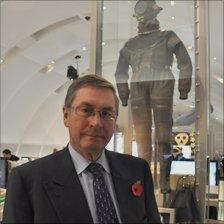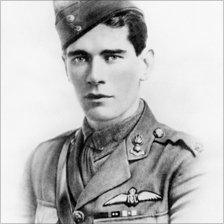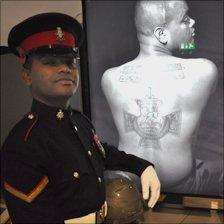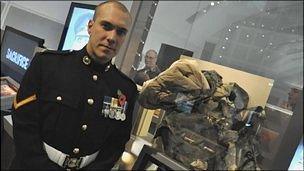Seven ways to earn a medal
- Published

Lord Ashcroft owns the world's largest collection of Victoria Crosses
Hundreds of Victoria and George Crosses have gone on display in a new gallery at the Imperial War Museum in London.
Paid for by a £5m donation from Lord Ashcroft, the exhibition honours the brave and tells the tales behind their remarkable deeds.
The Lord Ashcroft Gallery is housing his collection of 164 Victoria Crosses, the world's largest, alongside the IWM's 48 VCs and 31 George Crosses.
"It's significant that the underlying metal value of the VC is a baseless, virtually valueless piece of metal. Part of its symbolism is the lack of its intrinsic value," he said.
"When I meet medal holders I'm constantly surprised and humbled at their humbleness. They're ordinary people, and I mean that in a flattering sense."
The exhibition has been divided into seven qualities of bravery, with appropriate examples and accompanying medals placed in each category.
BOLDNESS
Leading Seaman James Magennis's Victoria Cross became Lord Ashcroft's first purchase of his medal collection, being bought in 1986.
LS Magennis, from Belfast, served in a mini submarine during World War II, the XE3. During its attack in 1945 on the Japanese cruiser Takao, moored just off Singapore, he made an exhausting dive to attach magnetic mines to the ship.
Afterwards, when XE3 became trapped under the Takao, LS Magennis had to dive again to release one of the jammed explosive charges attached to his submarine, smacking it with a spanner to release it.
The diving suit he used is on display in the exhibition.
Nigel Steel, the IWM's principal historian, has written definitions of each quality defined in the gallery, and describes boldness as "combining force with creative thinking".
AGGRESSION

Major Edward Mannock was an ace pilot but tortured by his many kills
Defined in the exhibition as "epitomising the idea of 'hot courage', acting quickly in the mayhem of battle", one notable gallery entry is that of Maj Edward Mannock, who lived in Canterbury and was awarded the Victoria Cross.
He was also credited as the most successful Allied World War I fighter ace.
Dogged by bad eyesight and crippled by what would today be recognised as post-traumatic stress disorder over his repeated killing, he was nevertheless known as an inspirational leader when serving in 1918 in France with the RAF's 85 Squadron.
He would, for example, fly with inexperienced pilots, badly damage an enemy aircraft and leave it for the rookie to finish off, in order to boost their confidence.
In June and July 1918, he engaged with and destroyed a large number of enemy aircraft over France and Flanders, but died in action on 26 July.
SKILL
Lt William Robinson, known as Leefe Robinson, won his Victoria Cross in 1916 and is the fastest ever recipient of the award.
Raised partly in India and a pilot with 39 Squadron of the Royal Flying Corps, he took on a German SL11 airship in a night-time raid over London in his BE2c plane.
A crowd of many thousands had gathered on the streets below to watch the battle. Flying through the anti-aircraft fire, he used special ammunition to set the airship alight by concentrating on one small part of it.
When it exploded, he was so close he could feel the heat as it fell to earth in flames.
He immediately became a national hero and was awarded the Victoria Cross three days later. But the mass public adulation did not sit well with him, so he went to the front in France, where he was captured, mistreated by the Germans and later died back in England after the war ended, in December 1918.
The museum defines skill as "wisdom, sound judgement and technical knowledge".
INITIATIVE
Pte Johnson Beharry's Warrior armoured vehicle was twice ambushed in Al Amarah, Iraq in 2004.
The first time he took the initiative, which the museum says requires "quick decisions and clear solutions".

L/Cpl Beharry had a Victoria Cross tattooed on his back
He drove his Warrior out of heavy fire, getting the wounded to safety and leading his comrades away from danger. The second time, despite a very serious head injury, he drove his vehicle to safety.
The 31-year-old, who lives in Dulwich, London, and has since been promoted to Lance Corporal, says he has only reflected on his Victoria Cross award for two minutes, since he was awarded it in 2005.
"I have been to three Victoria Cross and George Cross Association reunions, for those who hold either medal," he said. "At the last two I thought about how there are seven Victoria Cross holders alive, and I'm one of them.
"There are about seven billion people in the world, so that's one VC holder for every billion. What a ratio. But I've only thought about that twice, for a minute each time. I've never thought about my Victoria Cross other than that.
"I'm so humbled to be part of the Association, who are like my family, and this exhibition."
LEADERSHIP
John 'Tubby' Linton won his Victoria Cross for his exploits in charge of the HM Submarine Turbulent in the Mediterranean in WWII.
For three years, Cdr Linton led a relentless submarine campaign against German and Italian shipping.
Under his leadership, his crew destroyed a cruiser, destroyer, U-boat and 29 other ships, more than 100,000 tons of shipping. His submarine escaped 13 attacks and 250 depth charges before it was eventually sunk in March 1943.
His nickname came because, having once been fond of playing rugby, his physique broadened somewhat when confined to the narrow walls of a submarine.
Leadership is defined in the exhibition as coming from those who are "charismatic, strong, inspirational".
SACRIFICE
L/Cpl Matthew Croucher, of the Royal Marines, was awarded the George Cross for his heroism in Afghanistan in 2008, which he has loaned to the exhibition.

L/Cpl Croucher threw himself on a bomb to protect his colleagues
During a covert, night-time patrol of a Taliban bomb factory, L/Cpl Croucher tripped a booby-trapped bomb.
He immediately threw himself on the device to smother the explosion and save the lives of his patrol. His day pack, a type of backpack, was badly damaged but he survived the blast.
"It was an honour to be asked to be part of this exhibition," the 26-year-old from Birmingham said.
"It puts things in perspective for me. People sing my praises, but when I come into the gallery I see that my medal's just one of many. I shake my head at some of the things people have done."
Sacrifice, according to Mr Steel, "epitomises selfless responsibility".
ENDURANCE
Doreen Ashburnham was awarded a medal for fighting off a cougar in Canada in 1916.
The 11-year-old was attacked by a cougar on 23 September, near her home on Vancouver Island. She and her eight-year-old cousin, Anthony Farrer, fought off the big cat with their bare fists and riding whips as it mauled them.
At one point Doreen punched the animal in the mouth.
It finally fled, leaving them badly injured, but both survived and were awarded the Albert Medal. Doreen was the youngest female recipient, and Anthony was the youngest ever to receive the award.
In 1971 all British bravery medals - the Albert and Edward medals - were converted to the George Cross, and so the two were given that award.
Mr Steel describes endurance as being "the opposite of aggression, all about cold courage".